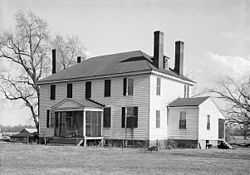Weyanoke, Virginia
|
Weyanoke | |
 | |
|
Weyanoke plantation house | |
 | |
| Location | Route 619 off Route 5, Charles City, Virginia |
|---|---|
| Coordinates | 37°17′30″N 77°3′56″W / 37.29167°N 77.06556°WCoordinates: 37°17′30″N 77°3′56″W / 37.29167°N 77.06556°W |
| Area | 1,225 acres (496 ha) |
| Built | c. 1790 |
| Architectural style | Georgian |
| Governing body | Private |
| NRHP Reference # | 80004406[1] |
| VLR # | 018-0029 |
| Significant dates | |
| Added to NRHP | March 10, 1980 |
| Designated VLR | September 21, 1976[2] |
Weyanoke is an unincorporated community in Charles City County, Virginia, United States. In 1619 the English transported enslaved Africans to the Weyanoke Peninsula. They created the first African community in North America. The Westover Plantation and related archaeological sites were listed on the National Register of Historic Places in 1980.[1]
The area was named for, and historically inhabited by, the Weanoc (also spelled Weyanoke) Indians, an Algonquian-speaking tribe of the Powhatan Confederacy.[3] The peripatetic movements of this tribe back and forth between their original home and North Carolina during the years following the Second Anglo-Powhatan War (1644–46) were extensively documented as part of the later boundary dispute between Virginia Colony and North Carolina Colony, and this unusual wealth of detailed information has been the subject of much study. At the heart of the dispute was the intended location of the "Weyanoke River" mentioned in the Carolina Charter boundaries, as the Weyanoke had by then lived on several rivers, and each colony produced many witnesses avowing that they had known various local rivers by that name.
Despite their many moves, the Weyanoke after 1646 became partly Anglicised, preferring to have some English-style houses built, rather than yehakans, wherever they moved. The colony, in assigning them reserve land on the upper Blackwater in 1650 (from which they were driven by colonists the following year), even expressed a desire to teach the Weyanokes the English concept of property ownership, and this was successful. In their subsequent wanderings, the Weyanoke always made land purchase or rental contracts with the chiefs of the Iroquoian-speaking Tuscarora and Nottoway tribes. By the 18th century, they had fully integrated with the Nottoways, and were speaking their language, their former presence visible only in the surname "Wineoak".
The Weyanoke Plantation includes a formal Georgian style mansion built in the 1790s and 40 archaeological sites. The mansion is a two-story frame house sheathed with molded weatherboards and set on a brick foundation. The original house was enlarged after 1938. Within the property's boundaries are the archaeological remains of man's continuous occupation which spans 10,000 years.[4]
The Weyanoke Association was formed in Charles City County in 1996 to help mixed-race African-American and Native American peoples research, understand and celebrate their joint heritages.[5]
References
- ↑ 1.0 1.1 "National Register Information System". National Register of Historic Places. National Park Service. 2010-07-09.
- ↑ "Virginia Landmarks Register". Virginia Department of Historic Resources. Retrieved 5 June 2013.
- ↑ "Upper Weyanoke", James River Plantations, National Park Service, accessed 5 Apr 2010
- ↑ Calder Loth, Martha McCartney and Nick Luccketti (April 1978). "National Register of Historic Places Inventory/Nomination: Weyanoke". and Accompanying photo
- ↑ The Weyanoke Association, Official Website, accessed 2 Apr 2010
External links
- The Weyanoke Association, Official Website
- "Upper Weyanoke", James River Plantations, National Park Service
- Weyanoke, Weyanoke Road, Weyanoke, Fairfax County, VA: 2 photos and 3 data pages at Historic American Buildings Survey
| ||||||||||||||


